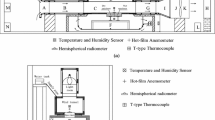Abstract
A new facility was presented which can expediently and cheaply measure the transient moisture content profile in multi-layer porous building envelope. Then, a common multi-layer porous building envelope was provided, which was constructed by cement mortar-red brick-cement plaster. With this kind of building envelope installed in the south wall, a well-controlled air-conditioning room was set up in Changsha, which is one of typical zones of hot and humid climate in China. And experiments were carried out to investigate the temperature and moisture distribution in multi-layer building envelope in summer, both in sunny day and rainy day. The results show that, the temperature and humidity at the interface between the brick and cement mortar are seriously affected by the changes of outdoor temperature and humidity, and the relative humidity at this interface keeps more than 80% for a long-term, which can easily trigger the growth of mould. The temperature and humidity at the interface between the brick and cement plaster change a little, and they are affected by the changes of indoor temperature and humidity. The temperature and humidity at the interface of the wall whose interior surface is affixed with a foam plastic wallpaper are generally higher than those of the wall without wallpaper. The heat transfer and moisture transfer in the envelope are coupled strongly.
Similar content being viewed by others
References
QIN Meng-hao, BELARBI R, AITMOKHTAR A, SEIGNEURIN A. An analytical method to calculate the coupled heat and moisture transfer in building materials [J]. International Communications in Heat and mass Transfer, 2006, 33(1): 39–48.
GUO Xing-guo, CHEN You-ming. Computational analysis of heat and moisture performance of multilayer wall in south China [J]. Journal of Central South University of Technology, 2008, 114(3): 106–110.
DESTA T Z, LANGMANS J, ROELS S. Experimental data set for validation of heat, air and moisture transport models of building envelopes [J]. Building and Environment, 2011, 46(5): 1038–1046.
WU Yang. Experimental study of hygrothermal properties for building materials [D]. Montreal: Concordia University, 2007.
TENWOLDE A. Steady-state one-dimensional water vapor movement by diffusion and convection in a multilayered wall [J]. ASHRAE Transactions, 1985, 91(1A): 322–342.
SHAKUN W. The causes and control of mold and mildew in hot and humid climates [J]. ASHRAE Transactions, 1996, 92: 1282–1292.
HOSNI M H, SIPES J M, WALLIS M H. Experimental results for diffusion and infiltration of moisture in concrete masonry walls exposed to hot and humid climates [J]. ASHRAE Transactions, 1999, 105(2): 191–203.
SU Xiang-hui. Research on coupled heat and moisture transfer in multilayer porous structure [D]. Nanjing: Nanjing University of Aeronautics and Astronautics, 2003: 69–73.
ROELS S, TALUKDAR P, JAMES C. Reliability of material data measurements for hygroscopic buffering [J]. International Journal of Heat and Mass Transfer, 2010, 53: 5355–5363.
JAMES C, SIMONSON C J. S, TALUKDAR P, ROELS S. Numerical and experimental data set for benchmarking hygroscopic buffering modes [J]. International Journal of Heat and Mass Transfer, 2010, 53(19/20): 3638–3654.
TALUKDAR P, OLUTMAYIN S O, OSANYINTOLA O F, SIMONSON C J. An experimental data set for benchmarking 1-D, transient heat and moisture transfer models of hygroscopic buildings materials. Part I: Experimental facility and material property data [J] International Journal of Heat and Mass Transfer, 2007, 50(23/24): 4527–4539.
ROELS S, CARMELIET J, HENS H, ADAN O, BROCKEN H, CERNY R, PAVLIK Z, ELLIS A T, HALL C, KUMARAN K, PEL L, PLAGGE R. A comparison of different techniques to quantify moisture content profiles in porous building materials [J]. Journal of Thermal Envelope and building Science, 2004, 27: 261–276.
NIZOVTSEV M I, STANKUS S V, STERLYAGOV A N, TEREKHOV V I, KHAIRULIN R A. Determination of moisture diffusivity in porous materials using gamma-method [J]. International Journal of Heat and Mass Transfer, 2008, 51: 4161–4167.
VANDERHEIJDEN G H A, HUININK H P, PEL L AND KOPINGA K. One-dimensional scanning of moisture in heated porous building with NMR [J]. Journal of Magnetic Resonance, 2011, 208(2): 235–242.
BAKER P H, BAILLY D, CAMPBELL M, GALBRAITH G H, CRAIGMCLEAN R, ROFFA N, SANDERS C H. The application of X-ray absorption to building moisture transport studies [J]. Measurement, 2007, 40(9/10): 951–959.
YE Z, TIROVIC M, DAVIES M, BAKER P H, DHILLIPSON M C, SANDERS C H, GALBRRAITH G H, McLEAN R C. The testing of two methods for the moisture measurement of building fabrics via comparisons with data from an X-ray system [J]. Building and Environment, 2009, 44: 1409–1217.
Author information
Authors and Affiliations
Corresponding author
Additional information
Foundation item: Project(51078127) supported by the National Natural Science Foundation of China
Rights and permissions
About this article
Cite this article
Chen, Gj., Liu, Xw., Chen, Ym. et al. Development of experimental study on coupled heat and moisture transfer in porous building envelope. J. Cent. South Univ. Technol. 19, 669–674 (2012). https://doi.org/10.1007/s11771-012-1055-9
Received:
Accepted:
Published:
Issue Date:
DOI: https://doi.org/10.1007/s11771-012-1055-9




